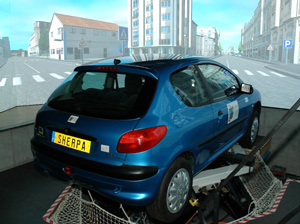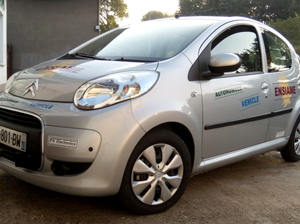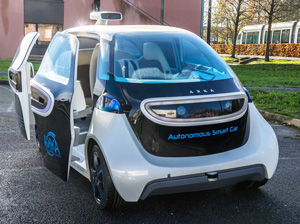Summary
The work carried out in the CoCoVeA project allowed:
- To define a multi-level cooperation architecture allowing the interactions between the driver and the autonomous vehicle both at the vehicle control level (vehicle guidance on the defined trajectory) and at the tactical level (choice of possible maneuvers type: change of lane, insertion, overtaking, etc.) ;
- To define the information needs of the driver to carry out his driving task and this according to the degree of automation (shared driving, PLC supervision, delegation, takeover) ;
- To define the HMI mechanisms to provide this information to the driver and to collect his instructions (visual, manual, sound, haptic GUIs), depending on the context and mode involved ;
- Define the monitoring needs of the driver during both the manual and the delegated driving phases in order to ensure the safety of the vehicle ;
- To define the mechanisms of transitions between driving modes and the conditions associated with these transitions in order to guarantee safety ;
- To prototype all this work in the form of an integrated system on a dynamic interactive driving simulator ;
- To prototype part of this work on a real vehicle ;
- To evaluate the prototype on the driving simulator in the context of an experiment involving a representative panel of drivers.
The CoCoVeA project demonstrated the need for close cooperation between the driver and the assistance system in order to guarantee the acceptability and safety of the autonomous vehicle. For this, a multi-level cooperation architecture was developed and prototyped on a driving simulator. The algorithms implemented in this architecture to solve the problems of control sharing, authority management, conflict resolution for decision-making have highlighted the need for a better knowledge of the "operation" of the driver.
Several axes emerge:
- The need for models of the driver describing both its decision-making and sensory-motor mechanisms. The models of the decision-making mechanisms that lead the driver to choose an alternative rather than another will make the behavior of the automatism with that of the driver homogeneous in order to favor the acceptability of the systems. They will also advance the problem of ethics in the field of the autonomous vehicle. The sensori-motor models will allow to refine the interfaces, especially haptic, between driver and system, for a better safety.
- The need for advanced driver monitoring. In many driving phases, it is necessary to relate the driver's operational capabilities to the requirements of the situation. Vigilance, workload, situation awareness, attention are all essential information for the modulation of the level of automation.
Several objectives are being pursued in the ANR AutoConduct project, led by the VeDeCom Institute, for which several partners of the CoCoVeA project are participating in the consortium.
Demonstrators
LAMIH Driving Simulator

www.uphf.fr/LAMIH/en/SHERPA
Video : https://pod.uphf.fr/video/0601-lamih-driving-simulator-sherpa/
C1 ENSIAME Prototype

www.uphf.fr/ensiame/le-vehicule-autonome
Video : https://pod.uphf.fr/video/0599-c1-ensiame-prototype-cocovea/
AKKA Link&Go Prototype

https://www.akka-technologies.com/en/innovation/projects/link-go
Video : https://youtu.be/Pc6RdqQX7Qc
Publications
Vulgarisation conferences
Collectif (2015). CNRS – Les Innovatives, « Véhicule du futur ». Présentation des projets ABV & CoCoVeA, Paris, mars.
International journals
NGUYEN T., SENTOUH C., POPIEUL J. (2017). Fuzzy Steering Control for Autonomous Vehicles under Actuator Saturation: Design and Experiments. Journal of the Franklin Institute, (In Press).
BENLOUCIF M., SENTOUH C., FLORIS J., SIMON P., POPIEUL J. (2017). Online adaptation of the Level of Haptic Authority in a lane keeping system considering the driver's state.Transportation Research Part F: Psychology and Behaviour, (In Press).
NGUYEN T., SENTOUH C., POPIEUL J. (2017). Sensor Reduction for Driver-Automation Shared Steering Control via an Adaptive Authority Allocation Strategy. IEEE/ASME Transactions on Mechatronics (TMECH) (In Press), Volume: PP, Issue: 99. [IF=4.357] [DOI=10.1109/TMECH.2017.2698216].
NGUYEN T., SENTOUH C., POPIEUL J. (2017). Driver-Automation Cooperative Approach for Shared Steering Control under Multiple System Constraints: Design and Experiments. IEEE Transactions on Industrial Electronics, 64 (5), pp. 3819-3830, ISSN 0278-0046. [IF=7.168] [DOI=10.1109/TIE.2016.2645146].
NGUYEN T., LAURAIN T., PALHARES R., LAUBER J., SENTOUH C., POPIEUL J. (2016). LMI-based Control Synthesis of Constrained Takagi-Sugeno Fuzzy Systems Subject to L2 or L-infinity Disturbances. Neurocomputing, 207, pp. 793-804. [IF=3.317] [DOI=10.1016/j.neucom.2016.05.063].
SOUALMI B., SENTOUH C., POPIEUL J-C., DEBERNARD S. (2014). Automation-driver cooperative driving in presence of undetected obstacles. IFAC Control Engineering Practice, 24, pp. 106–119.
International conferences
BENLOUCIF M., NGUYEN T., SENTOUH C., POPIEUL J. (2017). A New Scheme for Haptic Shared Lateral Control in Highway Driving Using Trajectory Planning. 20th IFAC World Congress, Toulouse, France, juillet.
BENLOUCIF M., SENTOUH C., FLORIS J., SIMON P., BOVERIE S., POPIEUL J. (2016). Cooperation between the driver and an automated driving system taking into account the driver's state. Driving Simulation and Virtual Reality Conference and Exhibition, Arts et Métiers Paris Tech, Paris, France, septembre.
BENLOUCIF M., POPIEUL J., SENTOUH C. (2016). Architecture for multi-level cooperation and dynamic authority management in an Automated Driving System – A case study on lane change cooperation. 13th IFAC/IFIP/IFORS/IEA Symposium on Analysis, Design, and Evaluation of Human-Machine Systems, Kyoto, Japan, août.
NGUYEN T., SENTOUH C., POPIEUL J. (2016). Takagi-Sugeno Model-based Steering Control for Autonomous Vehicles with Actuator Saturation. 4th IFAC Conference on Intelligent Control and Automation Sciences ICONS 2016, Volume 49, Issue 5, Reims, France, pp. 206-211, juin.
BENLOUCIF M., POPIEUL J., SENTOUH C. (2016). Multi-level cooperation between the driver and an automated driving system during lane change maneuver. 2016 IEEE Intelligent Vehicles Symposium (IV), Gothenburg, Sweden, pp. 1224-1229, juin.
NGUYEN T., SENTOUH C., POPIEUL J. (2015). Online adaptation of the authority level for shared lateral control of driver steering assist system using dynamic output feedback controller. 41st Annual Conference of the IEEE Industrial Electronics Society (IECON 2015), Yokohama, Japan, pp. 3767–3772, novembre.
NGUYEN T., LAURAIN T., LAUBER J., SENTOUH C., POPIEUL J. (2015). Non-quadratic approach for control design of constrained Takagi-Sugeno fuzzy systems subject to persistent disturbances. IEEE International Conference on Fuzzy Systems (FUZZ-IEEE 2015), Istanbul, Turkey, pp. 1-6, août.
NGUYEN T., SENTOUH C., POPIEUL J., SOUALMI B. (2015). Shared lateral control with online adaptation of the automation degree for driver steering assist system: A weighting design approach. IEEE 54th Annual Conference on Decision and Control, Osaka, Japan, pp. 857–862, décembre.
PACAUX-LEMOINE M., SIMON P., POPIEUL J. (2015). Human-Machine Cooperation principles to support driving automation systems design. 3rd International Symposium on Future Active Safety Technology Toward zero traffic accidents (FAST-zero’15), Gothenburg, Sweden, septembre.
PSA (2015). Présentation à ITS Bordeaux - ITS-1883 - Human factor issues for automated driving and autonomous car, 5-9 octobre.
BOVERIE S. (2014). Conférence invitée : « Les systèmes d'assistance à la conduite automobile, exemples d'applications de la logique floue », LFA’2014, Cargèse, , 22-24 octobre.
